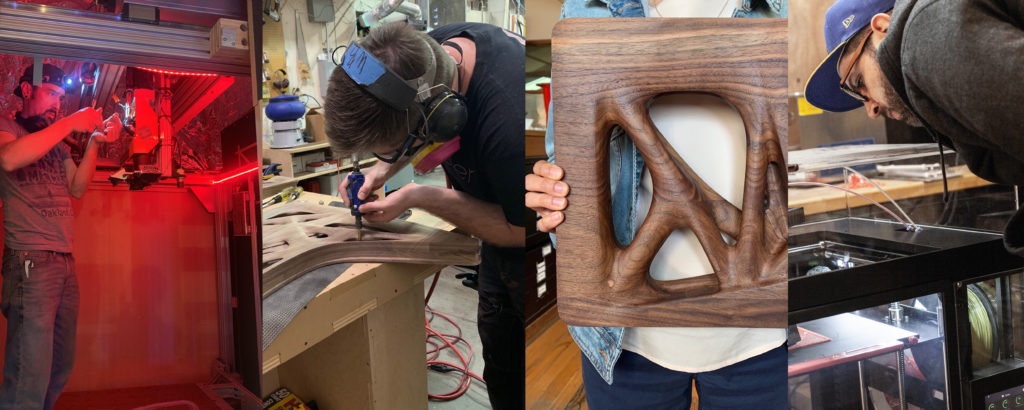Model No., started in Oakland, CA, in 2018, is a furniture manufacturer that uses PLA pellets derived from agricultural waste to 3D print made-to-order home furnishings. Model No.’s latest product line, a lighting collection, represents an entry into a new market sector for the company.

Sustainable Manufacturing
Including three different types of chandeliers and two types of floor lamps, the collection — like all the furniture Model No. makes — is printed from PLA pellets provided by NatureWorks LLC. Headquartered in Minnesota, NatureWorks is a subsidiary of agricultural products conglomerate Cargill (the US’s largest privately-held company by revenue), and PTT Public Company Limited, a Thai state-owned oil and gas company. The bioplastics that NatureWorks produces are made from a combination of food waste, corn and sugar cane detritus, beetroot, and wood dust.

Additionally, Model No. sources all of the wood used in its products from Forest Stewardship Council (FSC), a nonprofit organization that evaluates timber goods, providing certification to companies it considers to be responsible managers of forestry resources. Thus, by utilizing a multi-pronged approach of bioplastics, sustainable timber, and on-demand production, Model No. has created a structure that can continuously be built upon as the company scales up, to gradually make further improvements to its carbon footprint reductions.

Moreover, it’s not just the production process that sees benefits from the approach made by Model No. Although it still flies well under the radar, public perception has nonetheless become increasingly attuned in recent years to the fact that American furniture products are loaded with carcinogens, mainly used to make cushions more flame retardant. That leads to outgassing, or off-gassing: the slow evaporation of gases trapped in a material into the surrounding environment. Obviously, this becomes a problem when those gases are harmful to humans, and released indoors.

In an interview with Barron’s from this past March, Philip Raub, Model No.’s CEO, addressed how the company approaches the problem of off-gassing in its manufacturing process. He asserted that Model No. had this specifically in mind, when it set out to create a couch that was composed of the highest percentage possible of the most natural materials available. With the proliferation of cheap LEDs in recent years, it’s crucial that this same approach be taken to the lighting sector. The use of bioplastics also helps maximize the likelihood that at the end of their life cycles, lighting products can be recycled, rather than thrown away.
In the same interview mentioned above, Baum also said that one of the company’s major long-term strategic objectives is to open micro-factories, like the one at Model No. headquarters in Oakland, across the country. This would add the dimension of minimizing the distance of production from the point of sale, to the company’s multifaceted carbon emissions approach.
Petrochemicals vs. PLA
As with the rest of Model No.’s product lines, the lighting pieces are not cheap, running from a range of $330-480 per configuration for chandeliers. The floor lamps are even more expensive: the Eos series, available in five different styles, is $430, while the 3-Point Floor Lamp costs $800. Still, consumers whose purchases are driven by considerations of sustainability tend to be able to afford higher prices, and willing to spend more. Further, prices for such goods will likely eventually decrease at least somewhat, the more that the consumer market for sustainable manufacturing grows. In contrast, it seems likely that consumer goods made from petrochemicals will only continue to increase in price, as the rising rate of fossil fuel costs shows little signs that it will slow down, long-term.
Finally, the paradoxical nature of trying to consume ethically in a hydrocarbon-fueled, market-based economy is highlighted by companies such as NatureWorks, the supplier of Model No.’s PLA pellets. Aside from the question of whether PLA has truly meaningful advantages over petrochemical-based plastics in terms of carbon emissions, NatureWorks’ parent companies are an oil and gas firm (PTT), and Cargill. Former Congressman Henry Waxman once called the latter “the worst company in the world,” owing to its broad swath of environmental and human rights violations.
Thus, there is also the obvious question about whether NatureWorks is just a greenwashing campaign by its parent company. And, in turn, that brings up the problem of how much that actually matters if carbon emissions are reduced long-term, anyway. Over time, it would, of course, be preferable if every link in the supply chain were beyond reproach. For the foreseeable future, however, it seems like we are going to still largely be relying on polluters to drive greater adoption of sustainable practices.
Images courtesy of Model No.
Subscribe to Our Email Newsletter
Stay up-to-date on all the latest news from the 3D printing industry and receive information and offers from third party vendors.
You May Also Like
Precision at the Microscale: UK Researchers Advance Medical Devices with BMF’s 3D Printing Tech
University of Nottingham researchers are using Boston Micro Fabrication‘s (BMF) 3D printing technology to develop medical devices that improve compatibility with human tissue. Funded by a UK grant, this project...
3D Printing Webinar and Event Roundup: April 21, 2024
It’s another busy week of webinars and events, starting with Hannover Messe in Germany and continuing with Metalcasting Congress, Chinaplas, TechBlick’s Innovation Festival, and more. Stratasys continues its advanced training...
3D Printing Webinar and Event Roundup: March 17, 2024
It’s another busy week of webinars and events, including SALMED 2024 and AM Forum in Berlin. Stratasys continues its in-person training and is offering two webinars, ASTM is holding a...
3D Printed Micro Antenna is 15% Smaller and 6X Lighter
Horizon Microtechnologies has achieved success in creating a high-frequency D-Band horn antenna through micro 3D printing. However, this achievement did not rely solely on 3D printing; it involved a combination...





























